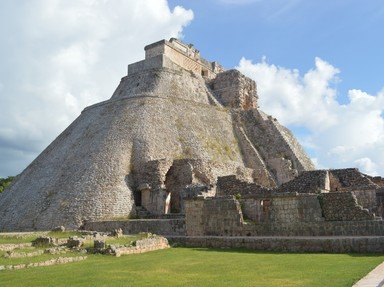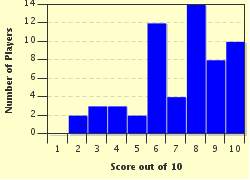Quiz Answer Key and Fun Facts
1. The first area we come to contains merchants offering pottery. These will be utilized for everyday use in the home or for ceremonial purposes. What is the typical color of the goods we see?
2. The next merchant we come to is selling a particular type of grain. In fact, it is the staple food of this Aztec culture. What food is he selling?
3. The next merchant is trying to sell us some blades to attach to our wooden sword called a macuahuitl. What are these blades made of that he has crafted?
4. The next merchant we speak with is a tradesman who is offering up some lovely feathers from a local bird to be used in a headdress, fan, or cape. What kind of bird might this be that had these greenish blue iridescent feathers?
5. The next merchant we deal with has traveled from the banks of Lake Texcoco. He is offering us a seasoning that we will use in most of our dishes and to preserve our meat. What is it?
6. We approach the next merchant, who is a jeweler. He has many golden necklaces and pendants but we are browsing through his ear plug selection. Why would a person wear this piece of jewelry, thick as a finger, through the ear lobe?
7. The next Aztec merchant with whom we converse is a hunter who has brought back an array of skins to be used for clothing, household goods, and royal throne coverings. A popular one for nobility seemed to be the skin of this large local cat that was considered one of the bravest animals around. What is it?
8. All of this shopping has made us hungry, so we were fortunate that the next merchant was selling ready-to-eat mixiotes. The maguey, or American aloe, leaves are steamed and hold a delicious treat inside. What will we find when we bite into one?
9. The next area at which we arrive is where we find several ticitls (curing doctors) who are selling their herbs and potions. They tell us they have a potion made with mesquite and morning dew that will help with certain ailments. In today's world we would go to an ophthalmologist for help. What are these healers treating?
10. We are almost at the end of our Aztec marketplace adventure. We have done much bartering and trading but realize we are almost out of the local 'currency' with which to buy anything else. What is the item that the Aztecs used for this purpose?
Source: Author
stephgm67
This quiz was reviewed by FunTrivia editor
bloomsby before going online.
Any errors found in FunTrivia content are routinely corrected through our feedback system.

